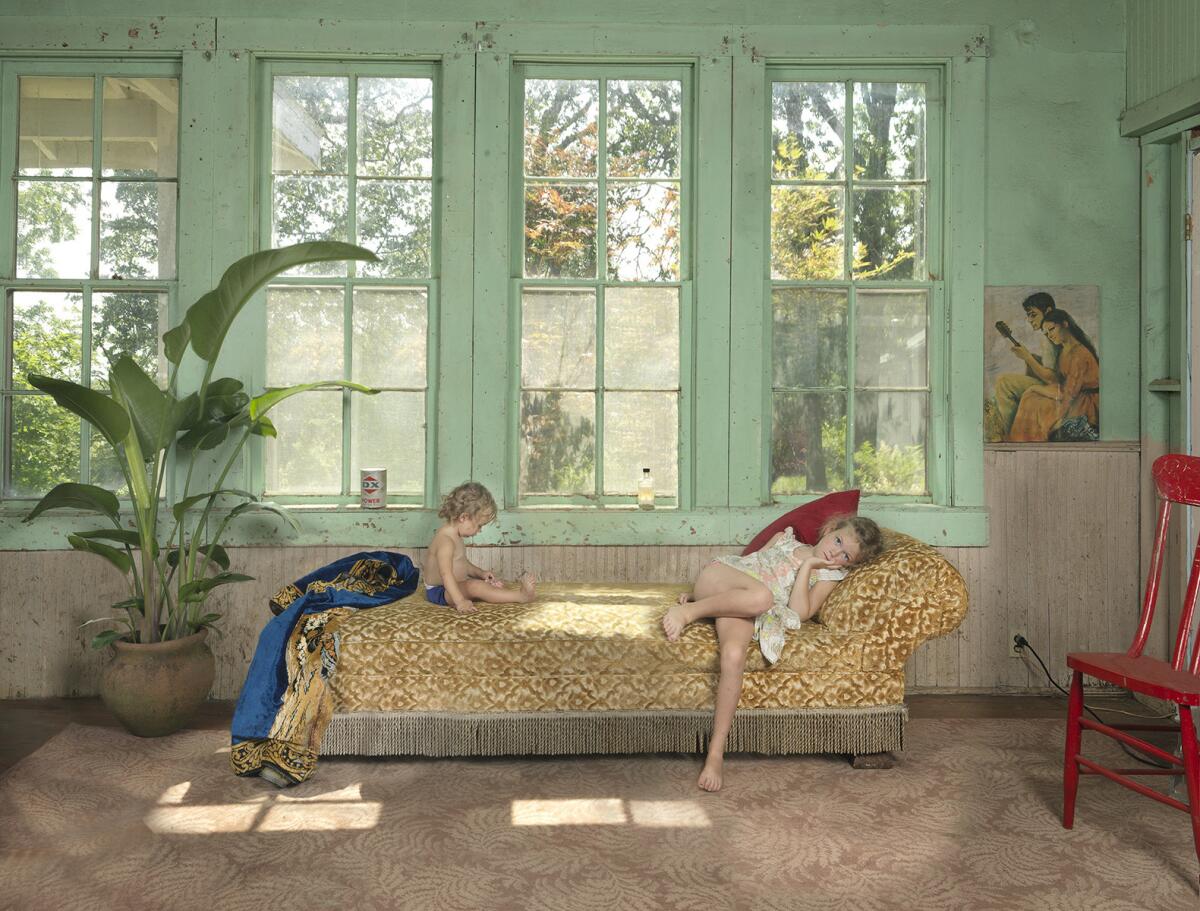Review: Julie Blackmon’s absorbing photography of everyday Midwestern life — or is it?
- Share via
The kids in Julie Blackmon's firecracker of a photograph, "The Hamster Handbook," have staged a scene on the floor of a screened-in porch: a miniature house with books for walls and small, furry pets scurrying within. Blackmon's scene, too, is staged, a domestic tableau scattered with small people acting out their self-defined roles and animal instincts. Both the play and the play-within-the-play nest inside the larger drama that is everyday life, Blackmon's ultimate theme and inspiration.
Based in Springfield, Mo., and part of a large extended family there, Blackmon uses home — backyards, attics, garages — and the rituals that unfold there as the raw material for a body of work begun nearly a decade ago. The large color prints in her show "Down Time" at Fahey/Klein Gallery date from the last five years. Each frame is an absorbing, meticulously orchestrated slice of ethnographic theater, starring a Midwestern tribe of scuffed and diapered blonds.
See the most-read stories in Entertainment this hour >>
Blackmon works in the same vein as Jeff Wall and Gregory Crewdson in creating vivid, persuasive photographic fictions. The artist she commonly cites as a chief influence, however, is Jan Steen, a 17th century Dutch painter whose witty and spirited tableaux, set in taverns and kitchens, often illustrated moralistic proverbs. Like Steen, Blackmon imposes compositional order on familiar, ordinary disarray. Each locale opens out to us like a theater set to its observing audience. Each scene is loaded with resonant details that thicken the sense of place and implied narrative.
Blackmon's work abounds with tender humor but also shrewdly subtle satire. It's no coincidence, for instance, that adults are all but absent here, and many of the situations depicted are spiked with the potential for danger — an unattended fire, bubble wrap encasing a young boy's head, popcorn strewn on a blanket in front of crawling babies. Perhaps every play ends up being a morality play. The freedom these children enjoy is a vanishing American resource, and Blackmon is nostalgic for it, for its loose and sloppy beauty. She edits out nearly all signs of contemporary technology or commercial branding, ever more gently pushing these scenes into a vaguely idealized past.

She unabashedly plunders the image pools of popular culture and art history. A photograph in her recently published book, "Homegrown," restages the Beatles' "Abbey Road" album cover with a line of kids pulling a wagon of Girl Scout cookies through the crosswalk. She conjures Balthus in the captivating "Chaise," posing a young girl with a bared hip and disarming stare in a deliciously moody, light-drenched room. In other pictures, she quotes the painter directly, lifting characters from his street scenes and depositing them into her own compressed, constructed universe, a rich, gray area at the intersection of nature and artifice, the sensual and the sanitized, innocence and experience.
------------
Fahey/Klein Gallery, 148 N. La Brea Ave., Los Angeles. Through Sept. 3; closed Sundays and Mondays. (323) 934-2250, www.faheykleingallery.com
Follow The Times’ arts team @culturemonster.
MORE ENTERTAINMENT NEWS
Jimmy Fallon to host 2017 Golden Globe Awards
'The Bachelorette' finally asks the important question: How does NFL pro Aaron Rodgers feel?
The biggest entertainment stories
Get our big stories about Hollywood, film, television, music, arts, culture and more right in your inbox as soon as they publish.
You may occasionally receive promotional content from the Los Angeles Times.







